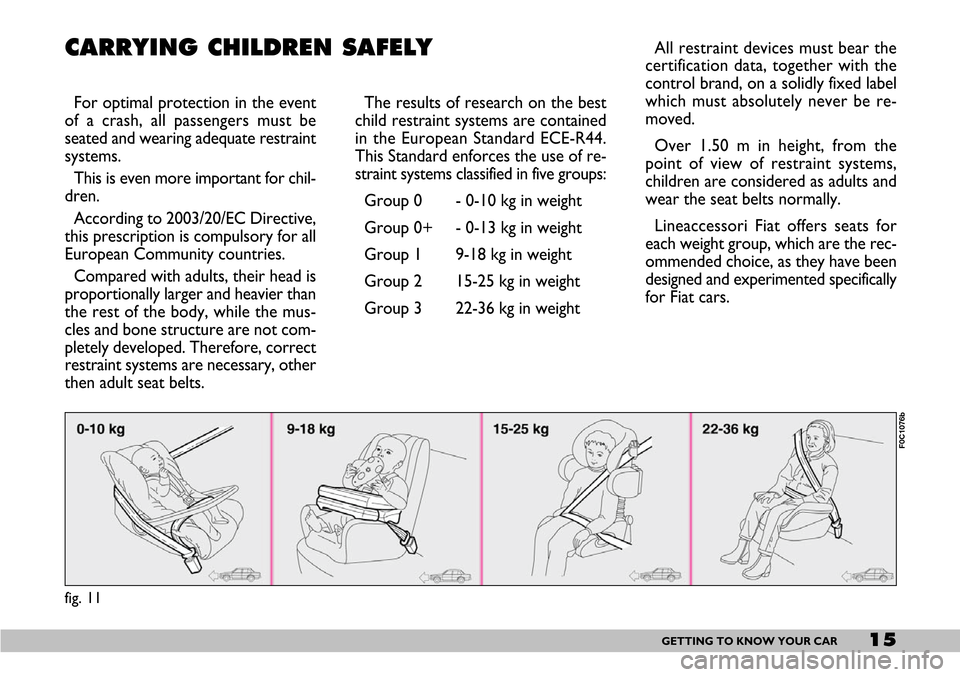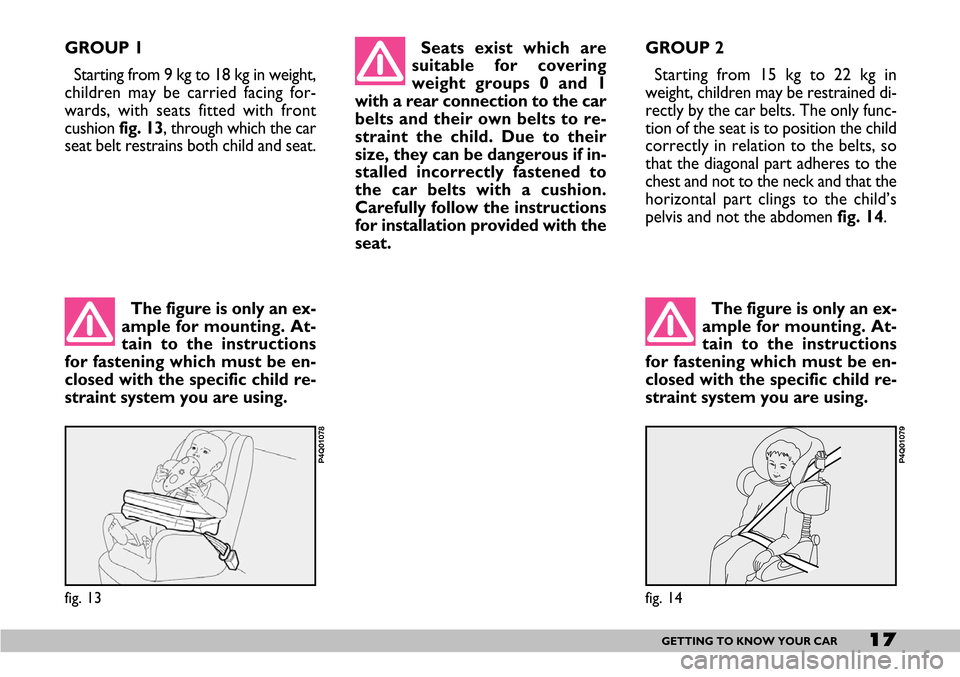Page 16 of 154

15GETTING TO KNOW YOUR CAR
fig. 11
F0C1076b
CARRYING CHILDREN SAFELY
For optimal protection in the event
of a crash, all passengers must be
seated and wearing adequate restraint
systems.
This is even more important for chil-
dren.
According to 2003/20/EC Directive,
this prescription is compulsory for all
European Community countries.
Compared with adults, their head is
proportionally larger and heavier than
the rest of the body, while the mus-
cles and bone structure are not com-
pletely developed. Therefore, correct
restraint systems are necessary, other
then adult seat belts.The results of research on the best
child restraint systems are contained
in the European Standard ECE-R44.
This Standard enforces the use of re-
straint systems classified in five groups:
Group 0 - 0-10 kg in weight
Group 0+ - 0-13 kg in weight
Group 1 9-18 kg in weight
Group 2 15-25 kg in weight
Group 3 22-36 kg in weightAll restraint devices must bear the
certification data, together with the
control brand, on a solidly fixed label
which must absolutely never be re-
moved.
Over 1.50 m in height, from the
point of view of restraint systems,
children are considered as adults and
wear the seat belts normally.
Lineaccessori Fiat offers seats for
each weight group, which are the rec-
ommended choice, as they have been
designed and experimented specifically
for Fiat cars.
Page 17 of 154

16GETTING TO KNOW YOUR CAR
fig. 12
P4Q01077
The figure is only an ex-
ample for mounting. At-
tain to the instructions
for fastening which must be en-
closed with the specific child re-
straint system you are using.
GROUPS 0 and 0+
Babies up to 13 kg must be carried
facing backwards on a cradle seat,
which, supporting the head, does not
induce stress on the neck in the event
of sharp deceleration.
The cradle is restrained by the car
seat belts, as shown infig. 12and in
turn it must restrain the child with its
own belts. SERIOUS DANGER: Never place cradle child’s seats on
the front passenger seat of cars fitted with passenger’s
air bag. The air bag activation could cause serious injuries,
even mortal. You are advised to carry children always on the rear seats,
as this is the most protected position in the case of a crash. In any case,
children’s seats must absolutely not be fitted on the front seat of cars
with passenger’s air bag, which during inflation could cause serious in-
jury, even mortal, regardless of the seriousness of the crash that trig-
gered it. Children may be placed on the front seat of cars fitted with
passenger’s air bag deactivation. In this case, it is absolutely necessary
to check the warning light
Fon the cluster to make sure that deacti-
vation has actually taken place (see paragraph “Passenger’s front air
bag” at item “Front air bags”). The front passenger’s seat shall be ad-
justed in the most backward position to prevent any contact between
child’s seat and dashboard.
Page 18 of 154

17GETTING TO KNOW YOUR CAR
fig. 13
P4Q01078
The figure is only an ex-
ample for mounting. At-
tain to the instructions
for fastening which must be en-
closed with the specific child re-
straint system you are using.
GROUP 1
Starting from 9 kg to 18 kg in weight,
children may be carried facing for-
wards, with seats fitted with front
cushion fig. 13, through which the car
seat belt restrains both child and seat.Seats exist which are
suitable for covering
weight groups 0 and 1
with a rear connection to the car
belts and their own belts to re-
straint the child. Due to their
size, they can be dangerous if in-
stalled incorrectly fastened to
the car belts with a cushion.
Carefully follow the instructions
for installation provided with the
seat.
fig. 14
P4Q01079
The figure is only an ex-
ample for mounting. At-
tain to the instructions
for fastening which must be en-
closed with the specific child re-
straint system you are using.
GROUP 2
Starting from 15 kg to 22 kg in
weight, children may be restrained di-
rectly by the car belts. The only func-
tion of the seat is to position the child
correctly in relation to the belts, so
that the diagonal part adheres to the
chest and not to the neck and that the
horizontal part clings to the child’s
pelvis and not the abdomen fig. 14.
Page 19 of 154

18GETTING TO KNOW YOUR CAR
Group Range Front Rear side Central
of weight passenger passenger Rear side
passenger
(if any)
Group 0, 0+ up to 13 kg U U (*)
Group 1 9-18 kg U U (*)
Group 2 15-25 kg U U (*)
Group 3 22-36 kg U U (*)
fig. 15
P4Q01080
GROUP 3
Starting from 22 kg to 36 kg in
weight, the size of the child’s chest no
longer requires a support to space the
child’s back from the seat back.
Fig. 15shows an example of proper
child positioning on the rear seat.
Children taller than 1.50 m can wear
seat belts like adults.PASSENGER SEATS
COMPLIANCE WITH
REGULATIONS ON CHILD’S
SEAT USE
Fiat 600 complies with the new
2000/3/EC Directive regulating child’s
seat assembling on the different car
seats according to the table on next
page.Key for the table on next page.
U = suitable for child restraint systems of the
“Universal” category, according to Euro-
pean Standard ECE R44 for the specified
“Groups”.
(*) No child’s seat can be installed on the rear
seat with lap belt (without reel).
Page 21 of 154

20GETTING TO KNOW YOUR CAR
IGNITION SWITCH
The key can be turned to four dif-
ferent positions fig. 16.
– STOP: engine off, key can be re-
moved and the steering column is
locked mechanically. Some electrical
devices can be used (e.g. sound sys-
tem).
– MAR: drive position. All electrical
devices can be used.
– AVV: engine ignition.
– PARK: engine off, parking lights
on, steering column locked. Press but-
ton Aand turn the key to PARK.
STEERING COLUMN LOCK
To engage the lock: remove the
ignition key at STOPor PARKand
turn the steering wheel until it locks. If the ignition switch has
been tampered with (e.g.
someone has tried to
steal your car), get a Fiat Deal-
ership to make sure it is still func-
tioning properly before you start
driving again.
Always remove the igni-
tion key when you get
out of the car. This will
prevent anyone from acciden-
tally working the controls. Re-
member to apply the handbrake
and, if the car is faced down on a
steep slope engage the first gear.
If it is facing up, engage the re-
verse gear.
Never remove the igni-
tion key while the car is
moving. The steering
wheel would automatically lock
as soon as you try to turn it. This
also applies when the car is being
towed.
fig. 16
P4Q00004
To release the lock: rock the
steering wheel slightly as you turn the
ignition key to MAR.
It is absolutely forbidden
to carry out whatever af-
ter-market operation in-
volving steering system or steer-
ing column modifications (e.g.: in-
stallation of anti-theft Device)
that could badly affect perfor-
mance and safety, cause the lapse
of warranty and also result in
non-compliance of the car with
homologation requirements.
Page 22 of 154
21GETTING TO KNOW YOUR CAR
DASHBOARD
Left-hand drive versions
The presence and position of the instruments and warning and indicator lights may vary according to the version of the car.
1.Left speaker housing - 2.Side window defroster/demister vents - 3.External light control stalk - 4.Horn - 5.Instrument
panel - 6.Steering wheel and airbag - 7.Windscreen/rear window wiper/washer control stalk - 8.Central air vents -
10.Windscreen defroster/demister vents - 11.Oddment compartment - 12.Right speaker housing - 13.Side window de-
froster/demister vents - 14.Oddment compartment under dashboard - 15.Control buttons - 16.Electric window controls
- 17.Heating and ventilation controls - 18.Sound system housing/oddment compartment - 19.Headlight adjustment con-
trol - 20.Ignition switch - 21.Fusebox.
P4Q00225fig. 17
Page 23 of 154
22GETTING TO KNOW YOUR CAR
INSTRUMENT PANEL
A.Clock setting button
B.Speedometer
C.Fuel level gauge
D.Trip meter reset button
E. Kilometre or mileage counter
F. Clock.
P4Q01004
fig. 18
Page 24 of 154
23GETTING TO KNOW YOUR CAR
INSTRUMENTS
SPEEDOMETER COUNTER
fig. 19
A- Kilometre counter.
B- Speedometer.
C- Trip meter reset button. Press
to reset fig. 20.FUEL LEVEL GAUGE
When the reserve warning light
comes on A-fig. 21 there are still
about 7 litres of fuel in the tank.
E -tank empty.
F -tank full (see the indications given
in paragraph “At the filling station").
Do not travel with the fuel tank al-
most empty: the gaps in fuel delivery
could damage the catalyser.
fig. 19
P4Q01006
P4Q01009
fig. 20fig. 21
P4Q00228
Press briefly = switch from kilome-
tre counter to trip meter and vice
versa.
Press longer = reset trip meter.
D- Kilometre counter display
fig. 20.